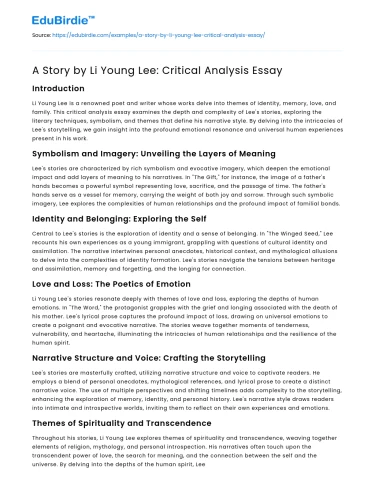Introduction
Li Young Lee is a renowned poet and writer whose works delve into themes of identity, memory, love, and family. This critical analysis essay examines the depth and complexity of Lee's stories, exploring the literary techniques, symbolism, and themes that define his narrative style. By delving into the intricacies of Lee's storytelling, we gain insight into the profound emotional resonance and universal human experiences present in his work.
Symbolism and Imagery: Unveiling the Layers of Meaning
Lee's stories are characterized by rich symbolism and evocative imagery, which deepen the emotional impact and add layers of meaning to his narratives. In "The Gift," for instance, the image of a father's hands becomes a powerful symbol representing love, sacrifice, and the passage of time. The father's hands serve as a vessel for memory, carrying the weight of both joy and sorrow. Through such symbolic imagery, Lee explores the complexities of human relationships and the profound impact of familial bonds.
Save your time!
We can take care of your essay
- Proper editing and formatting
- Free revision, title page, and bibliography
- Flexible prices and money-back guarantee
Identity and Belonging: Exploring the Self
Central to Lee's stories is the exploration of identity and a sense of belonging. In "The Winged Seed," Lee recounts his own experiences as a young immigrant, grappling with questions of cultural identity and assimilation. The narrative intertwines personal anecdotes, historical context, and mythological allusions to delve into the complexities of identity formation. Lee's stories navigate the tensions between heritage and assimilation, memory and forgetting, and the longing for connection.
Love and Loss: The Poetics of Emotion
Li Young Lee's stories resonate deeply with themes of love and loss, exploring the depths of human emotions. In "The Word," the protagonist grapples with the grief and longing associated with the death of his mother. Lee's lyrical prose captures the profound impact of loss, drawing on universal emotions to create a poignant and evocative narrative. The stories weave together moments of tenderness, vulnerability, and heartache, illuminating the intricacies of human relationships and the resilience of the human spirit.
Narrative Structure and Voice: Crafting the Storytelling
Lee's stories are masterfully crafted, utilizing narrative structure and voice to captivate readers. He employs a blend of personal anecdotes, mythological references, and lyrical prose to create a distinct narrative voice. The use of multiple perspectives and shifting timelines adds complexity to the storytelling, enhancing the exploration of memory, identity, and personal history. Lee's narrative style draws readers into intimate and introspective worlds, inviting them to reflect on their own experiences and emotions.
Themes of Spirituality and Transcendence
Throughout his stories, Li Young Lee explores themes of spirituality and transcendence, weaving together elements of religion, mythology, and personal introspection. His narratives often touch upon the transcendent power of love, the search for meaning, and the connection between the self and the universe. By delving into the depths of the human spirit, Lee invites readers to contemplate the mysteries of existence and the transformative potential of introspection and self-discovery.
Conclusion
Li Young Lee's stories are a testament to his mastery of storytelling and his ability to touch readers' hearts and minds. Through symbolism, imagery, and nuanced exploration of themes, Lee crafts narratives that delve into the complexities of human experience. His stories invite readers on a journey of self-reflection, empathy, and emotional resonance. By critically analyzing Lee's storytelling techniques and the themes present in his work, we uncover the profound beauty and universal truths that make his stories enduring and impactful.






 Stuck on your essay?
Stuck on your essay?

